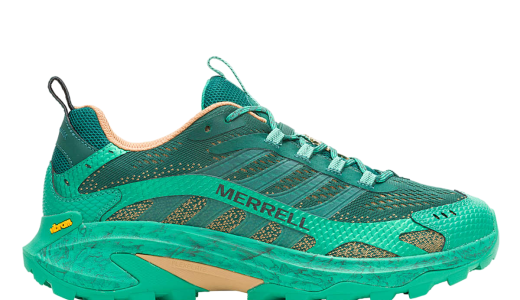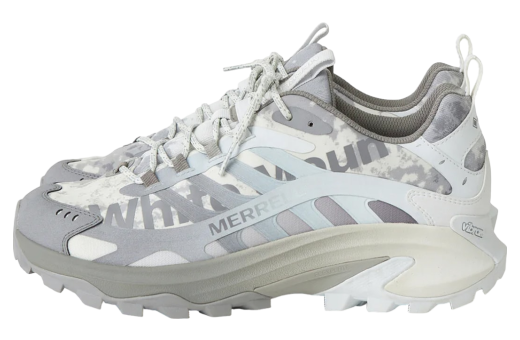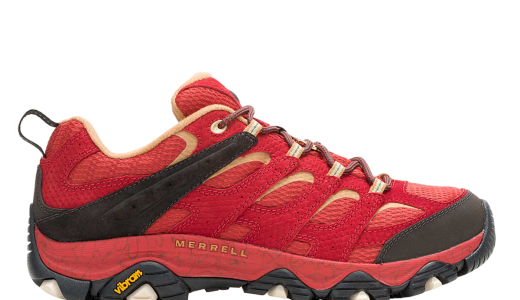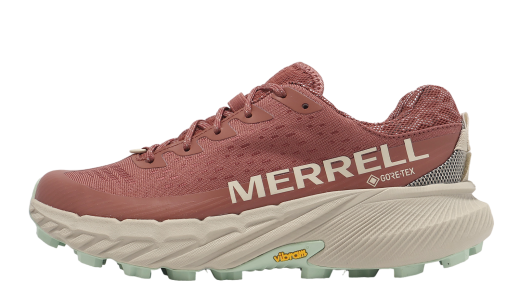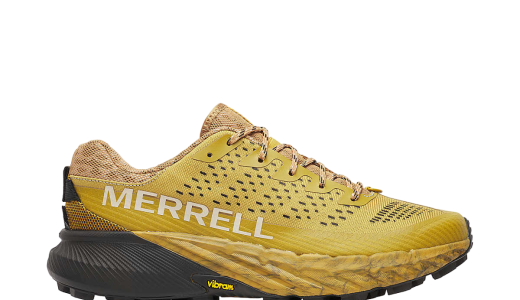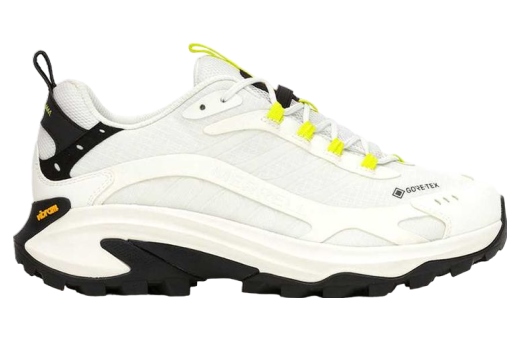Merrell
Merrell has established itself as a leading brand in outdoor footwear, offering a diverse range of sneakers that cater to both adventurous pursuits and daily activities. Known for their commitment to quality and performance, Merrell sneakers are equipped with features designed to enhance comfort and durability in various environments. Many models feature Vibram outsoles, renowned for their exceptional traction on diverse terrains, making them ideal for hiking trails or navigating urban landscapes with confidence.
Merrell sneakers often incorporate Air Cushion technology in the heel for superior shock absorption, promoting stability and comfort during long walks or hikes. The footwear's breathable mesh uppers facilitate airflow, keeping feet cool and dry, while protective elements such as toe caps and water-resistant treatments ensure durability and resilience against the elements. Designed with a focus on comfort, Merrell sneakers also include cushioned footbeds and supportive arch designs, ensuring a comfortable fit for extended wear.
Whether you're exploring rugged trails or simply enjoying a stroll in the city, Merrell sneakers blend functionality with style, catering to outdoor enthusiasts and urban adventurers seeking reliable footwear that performs in any environment.
History of Merrell
Origins and Early Years
Merrell was founded in 1981 by Randy Merrell, Clark Matis, and John Schweitzer. Randy Merrell, a skilled craftsman, initially started his career crafting custom cowboy boots. Matis and Schweitzer, who were former product managers at the Rossignol ski company, recognized the growing market needs for comfortable yet durable hiking boots. They approached Merrell with a proposal to create a new line of high-performance hiking boots, and the company was born.
First Steps: The Evolution of an Iconic Brand
The trio's collaboration was aimed at merging American craftsmanship with European boot-making technology. Merrell focused on producing custom-made, hand-stitched boots that offered superior fit, comfort, and durability. Their first product was the Merrell “Moab” (Mother Of All Boots). It became an instant hit among hikers and outdoor enthusiasts.
The entire philosophy behind these boots was to ensure they could withstand the rigors of backcountry hiking while offering unbeatable comfort. The early models of Merrell boots featured Italian leather, Norwegian welting techniques, and innovative components such as Vibram outsoles. These boots were designed to excel in both durability and performance.
Rapid Growth and Expansion: Wearing the World
By the mid-1980s, Merrell’s reputation had begun to spread beyond the American outdoors community. The brand started receiving endorsements from magazine editors as well as accolades for its high-quality products.
In 1987, the company expanded its offerings to include lighter, more versatile models aimed at not just hardcore alpinists but also the growing number of recreational hikers and day-trail enthusiasts. Their sales soared, and the company continued to gain prominence in the outdoor apparel industry.
Acquisition by Karhu: Paving the Way for Global Reach
In 1987, the Finnish company Karhu, recognizing Merrell’s potential, bought the brand. This acquisition was instrumental in taking Merrell to the next level. With access to more resources, Merrell was able to expand into international markets and streamline its manufacturing processes while maintaining the same high standards of quality.
Under Karhu's guidance, Merrell further diversified its product line to include all sorts of outdoor footwear, from trail-running shoes to sandals and everyday wear. This expansion helped the brand grow its customer base well beyond the boundaries of traditional hikers.
Introduction of the Jungle Moc: Redefining Utility
Perhaps one of the most notable product launches post-acquisition was the introduction of the Jungle Moc in 1998. This slip-on shoe was designed for casual use but incorporated the same DNA of durability and comfort that was synonymous with Merrell's hiking boots.
The Jungle Moc became immensely popular, almost cult-like, for its lightweight comfort and ease of use. It showed Merrell’s ability to adapt to changing consumer needs while adhering to their core philosophy of producing high-quality, reliable footwear.
Wolverine World Wide Acquisition: Further Elevation
In 1997, Merrell was acquired by Wolverine World Wide, a company with a solid history of high-quality shoemaking dating back to 1883. This acquisition opened new horizons for Merrell, as it benefited from Wolverine's extensive network and expertise in shoe production and global distribution.
Wolverine injected significant investment into the brand, which allowed Merrell to delve into research and development. This led to advancements in footwear technology, like the use of Gore-Tex for waterproofing and the integration of air-cushioning midsoles.
Expanding Beyond Footwear: Apparel and Accessories
Riding on the wave of its success in footwear, Merrell began to diversify its product offerings in the early 2000s. The brand launched a line of outdoor apparel, which included jackets, pants, shirts, and accessories designed to meet the rigorous demands of the great outdoors. These products were crafted with the same attention to detail and quality as their shoes, allowing consumers to trust the brand for a complete outdoor gear solution.
The apparel line received positive reviews and helped Merrell further entrench itself as a go-to brand for outdoor enthusiasts. This was a strategic move that allowed Merrell to tap into the growing market of outdoor lifestyle apparel.
The "Art of the Outside": Merrell's Ethos and Evolution
With changing times, consumer interests, and market dynamics, Merrell continued to evolve. The brand began to embrace a more inclusive, diverse approach to outdoor activities. It started to advocate that the outdoors were for everyone, regardless of age, gender, or skill level. This is encapsulated in their brand ethos, often referred to as “The Art of the Outside.”
Merrell invested in marketing campaigns and community outreach programs to make outdoor activities more accessible and inclusive. They partnered with various organizations to promote environmental conservation and sustainable practices, echoing the growing consumer awareness around these issues.
Digital Transformation: Stepping into the Future
With the dawn of the digital age, Merrell embraced technology to enhance its operational efficiency and consumer reach. The company established a strong online presence with an advanced e-commerce platform, allowing customers from around the world to purchase their favorite Merrell products with ease.
Moreover, Merrell began integrating digital tools and technologies in its product development processes. For example, they used 3D modeling and printing to enhance product design and accelerate the prototyping process. This allowed Merrell to remain agile and responsive to market trends and consumer preferences.
Challenges and Resilience: Navigating Economic Downturns and Competition
Like any long-standing brand, Merrell faced its fair share of challenges. The economic downturns and rising competition in the outdoor apparel market posed significant hurdles. However, Merrell's commitment to quality and continuous innovation helped them navigate these tough times.
For instance, during the 2008 economic crisis, Merrell launched the "Barefoot" line of minimalist running shoes. This was a bold move inspired by the growing trend of barefoot running. These shoes were designed to offer the benefits of barefoot running while providing adequate protection and support. The innovative line helped Merrell capture a new segment of health-conscious and adventure-loving consumers.
Sustainable Practices: Protecting the Future of the Outdoors
In recent years, Merrell has placed significant emphasis on sustainability. Recognizing the importance of environmental stewardship, the brand has made concerted efforts to reduce its carbon footprint and promote sustainable practices.
Merrell introduced several eco-friendly initiatives, such as using recycled materials in their products, reducing waste in their manufacturing processes, and ensuring ethical sourcing of raw materials. The brand also collaborates with various environmental organizations to support conservation projects and raise awareness about the importance of protecting the natural world.
Celebrating Milestones and Achievements
As Merrell approached its 40th anniversary in 2021, the brand celebrated several milestones and achievements. From gaining global recognition to launching groundbreaking products, Merrell's journey has been nothing short of remarkable.
One of the significant achievements was being recognized in the outdoor industry for their contributions to innovation and sustainability. Merrell's continuous effort to push the boundaries of performance, comfort, and environmental responsibility has garnered them numerous awards and accolades over the years.
Looking Ahead: Merrell’s Vision for the Future
As we look to the future, Merrell remains committed to its core values of quality, innovation, and inclusivity. The brand is poised to continue its growth by expanding its product offerings, embracing new technologies, and fostering a deeper connection with the global outdoor community.
Merrell’s vision for the future includes further investment in sustainable practices, exploring advanced materials and technologies, and continuing to promote the idea that the outdoors should be accessible to all. With a strong foundation built on decades of craftsmanship, innovation, and consumer trust, Merrell is well-positioned to navigate the evolving landscape of the outdoor industry.
Conclusion
From its humble beginnings in 1981 to becoming a global leader in outdoor footwear and apparel, Merrell’s journey is a testament to the power of innovation and perseverance. The brand's unwavering commitment to quality, comfort, and durability has earned it a loyal customer base and a prominent place in the outdoor industry.
As Merrell continues to innovate and adapt to the changing needs of outdoor enthusiasts, it remains steadfast in its mission to inspire people to experience the joy of the outdoors. With a focus on sustainability and inclusivity, Merrell is not just a brand; it’s a movement that encourages everyone to embrace the great outdoors and take care of our planet for generations to come.
